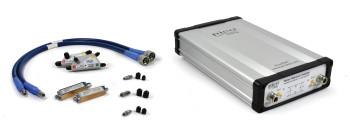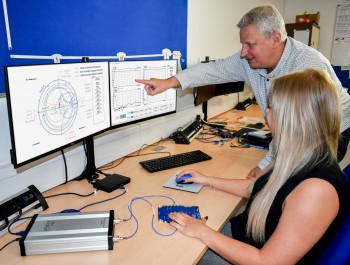ベクトルネットワークアナライザ PicoVNA
Pico Technology
- PicoVNA Vector Network Analyzer
高性能、携帯性、低コスト
- 300 kHz ~ 6 GHz または 8.5 GHz 動作
- 1秒あたり最大5500デュアルポートの高速Sパラメータ
- 1秒あたり10000以上の S11 + S21 データ
- 最適な精度を実現するクワッドRX 4レシーバアーキテクチャ
- 10 Hz帯域幅で最大124 dBのダイナミックレンジ
- 最大帯域幅140 kHzで0.005 dB RMSトレースノイズ
- ハーフラック、省スペース、軽量パッケージ
- Microsoft WindowsインターフェースからUSB経由でPC制御
- 参照面のオフセットと埋め込み解除
- 時間領域とポートのインピーダンス変換
- Touchstoneを含む、表形式およびグラフィックの印刷および保存形式
- 高速デバイスプロファイリング(PicoVNA 108)のトリガー時に保存
- VSWR補正を備えたデュアル周波数ミキサー測定(PicoVNA 108)
- P1dB、AMからPM、およびスタンドアロンの信号発生器ユーティリティ
- ガイド付きの8および12項および絶対パワー校正プロセス
- unknown through および 接続されたDUTアイソレーションを含む6つのキャリブレーションモード
製品仕様
PicoVNA 106 / PicoVNA 108
| Receiver characteristics | |||||||||
|---|---|---|---|---|---|---|---|---|---|
| Parameter | Value (PicoVNA 106) |
Value (PicoVNA 108) 【NEW】 |
Conditions | ||||||
| Measurement bandwidth | 140 kHz, 70 kHz, 35 kHz, 15 kHz, 10 kHz, 5 kHz, 1 kHz, 500 Hz, 100 Hz, 50 Hz, 10 Hz | ||||||||
| Average displayed noise floor |
|
|
Relative to the test signal level set to maximum power after an S21 calibration. Ports terminated as during the isolation calibration step. |
||||||
| Dynamic range |
See dynamic range in the product features. Excludes crosstalk. |
10 Hz bandwidth |
|||||||
| Temperature stability, typical | 0.02 dB/ °C for F < 4 GHz 0.04 dB/ °C for F ≥ 4 GHz |
Measured after an S21 calibration | |||||||
| Trace noise, dB RMS |
|
201-point sweep covering 1 MHz to 6 GHz or 8.5 GHz. Test power set to 0 dBm. |
|||||||
| Measurement uncertainty | See table below | Test level of –3 dBm No averaging Bandwidth 10 Hz Ambient temperature equal to the calibration temperature. A 12 error term calibration is assumed carried out with a good quality 3.5 mm calibration kit capable of achieving the performance specified. |
|||||||
| Spurious responses | –76 dBc typical, –70 dBc max. | The main spurious response occurs at close to (2 x RF + 1.3) MHz, where RF is the test frequency in MHz. For example, when testing a bandpass filter with a centre frequency of, say 1900 MHz, an unwanted response will occur around 949.35 MHz. There may also be spurious responses close to (3 x RF + 2.6) MHz. In all known cases the levels will be as stated. | |||||||
| Measurement uncertainty - value | |||||
|---|---|---|---|---|---|
| PC3.5 test port interfaces | |||||
| Reflection measurements | Transmission measurements | ||||
| Freq. range | Magnitude | Phase | Freq. range | Magnitude | Phase |
| –15 dB to 0 dB | 0 dBm to +6 dBm | ||||
| < 2 MHz | 0.7 dB | 8° | < 2 MHz | 0.4 dB | 6° |
| > 2 MHz | 0.5 dB | 4° | > 2 MHz | 0.2 dB | 2° |
| –25 dB to –15 dB | –40 dB to 0 dB | ||||
| < 2 MHz | 0.8 dB | 6° | < 2 MHz | 0.2 dB | 2° |
| > 2 MHz | 1.0 dB | 6° | > 2 MHz | 0.1 dB | 1° |
| –30 dB to –25 dB | –60 dB to –40 dB | ||||
| < 2 MHz | 3.0 dB | 20° | < 2 MHz | 0.5 dB [106] 0.3 dB [108] |
8° |
| > 2 MHz | 2.5 dB [106] 3.0 dB [108] |
15° 20° |
> 2 MHz | 0.3 dB | 4° |
| –80 dB to –60 dB | |||||
| < 2 MHz | 2.0 dB | 15° | |||
| > 2 MHz | 1.5 dB | 12° | |||
| SMA test port interfaces | |||||
| –15 dB to 0 dB | +0 dBm to +6 dBm | ||||
| < 2 MHz | 0.99 dB | 11.3° | < 2 MHz | 0.57 dB | 8.5° |
| > 2 MHz | 0.71 dB | 5.7° | > 2 MHz | 0.28 dB | 2.8° |
| –25 dB to –15 dB | –40 dB to 0 dB | ||||
| < 2 MHz | 1.13 dB | 14.1° | < 2 MHz | 0.42 dB | 2.8° |
| > 2 MHz | 1.41 dB | 8.5° | > 2 MHz | 0.14 dB | 1.4° |
| –30 dB to –25 dB | –60 dB to –40 dB | ||||
| < 2 MHz | 4.24 dB | 28.3° | < 2 MHz | 0.71 dB | 11.3° |
| > 2 MHz | 3.54 dB | 21.2° | > 2 MHz | 0.42 dB | 5.7° |
| –80 dB to –60 dB | |||||
| < 2 MHz | 2.83 dB | 21.2° | |||
| > 2 MHz | 2.12 dB | 17.0° | |||
| Test port characteristics | |||||||||
|---|---|---|---|---|---|---|---|---|---|
| Parameter | PicoVNA 106 | PicoVNA 108 | Conditions | ||||||
| Load match |
|
||||||||
| Source match |
|
||||||||
| Directivity |
|
||||||||
| Crosstalk |
|
|
Corrected. Both calibrated ports terminated in short circuits. After isolation calibration. |
||||||
| Maximum input level | +10 dBm, typ | 0.1 dB compression | |||||||
| Maximum input level | +20 dBm | +23 dBm | No damage | ||||||
| Impedance | 50 Ω | ||||||||
| Connectors | Type N(f) | ||||||||
| Bias-T input characteristics | |||
|---|---|---|---|
| Parameter | PicoVNA 106 | PicoVNA 108 | Conditions |
| Maximum current | 250 mA | ||
| Maximum DC voltage | ±15 V | ||
| Current protection | Built-in resettable fuse | ||
| DC port connectors | SMB(m) | ||
| Sweep I/O characteristics | |||
|---|---|---|---|
| Sweep trigger output voltage | Low: 0 V to 0.8 V High: 2.2 V to 3.6 V |
||
| Sweep trigger input voltage | Low: –0.1 V to 1 V High: 2.0 V to 4 V |
||
| Sweep trigger input voltage | ±6 V | No damage | |
| Sweep trigger in/out connectors | BNC(f) on back panel | ||
| Measuring functions | |||
|---|---|---|---|
| Measuring parameters | S11, S21, S22, S12 P1dB (1 dB gain compression) AM-PM conversion factor (PM due to AM) Mixer conversion loss, return loss, isolation and compression (PicoVNA 108 only) |
||
| Error correction | 12 error term full S-parameter correction (insertable DUT) 12 error term full S-parameter correction (non-insertable DUT) 8 error term full S-parameter unknown thru correction (non-insertable DUT) S11 (1-port correction) De-embed (2 embedding networks may be specified), impedance conversion S21 (normalize, normalize + isolation) S21 (source match correction + normalize + isolation) Averaging, smoothing Hanning and Kaiser–Bessel filtering on time-domain measurements Electrical length compensation (manual) Electrical length compensation (auto) Effective dielectric constant correction |
||
| Display channels | 4 channels | ||
| Traces | 2 traces per display channel | ||
| Display formats | Amplitude (logarithmic and linear) Phase, Group Delay, VSWR, Real, Imaginary, Smith Chart, Polar, Time Domain |
||
| Memory trace | One per display channel | ||
| Limit lines | 6 segments per channel (overlap allowed) | ||
| Markers | 8 markers | ||
| Marker functions | Normal, Δ marker, fixed marker, peak / min. hold, 3 dB and 6 dB bandwidth | ||
| Sweep functions | ||||||||||||||||||||||||
|---|---|---|---|---|---|---|---|---|---|---|---|---|---|---|---|---|---|---|---|---|---|---|---|---|
| Parameter | PicoVNA 106 | PicoVNA 108 | Conditions | |||||||||||||||||||||
| Sweep type | Linear sweep CW sweep (timed sweep) Power sweep (P1dB utility) |
|||||||||||||||||||||||
| Sweep times |
|
10 MHz to 6 GHz or 8.5 GHz, 201-point trace length. For other lengths and bandwidths, sweep time is approximately: |
||||||||||||||||||||||
| Number of sweep points, VNA mode | 51, 101, 201, 401, 801, 1001, 2001, 4001, 5001, 6001, 7001, 8001, 9001,10001 | |||||||||||||||||||||||
| Number of sweep points, TDR mode | 512, 1024, 2048, 4096 | |||||||||||||||||||||||
| Signal source characteristics | |||||||||||||
|---|---|---|---|---|---|---|---|---|---|---|---|---|---|
| Parameter | PicoVNA 106 | PicoVNA 108 | Conditions | ||||||||||
| Frequency range | 300 kHz to 6.0 GHz | 300 kHz to 8.5 GHz | |||||||||||
| Frequency setting resolution | 10 Hz | ||||||||||||
| Frequency accuracy | 10 ppm max | With ambient of 23 ±3 °C | |||||||||||
| Frequency temperature stability | ±0.5 ppm/ºC max | Over the range +15 °C to +35 °C | |||||||||||
| Harmonics | –20 dBc max | With test power set to < –3 dBm | |||||||||||
| Non-harmonic spurious | –40 dBc typical | ||||||||||||
| Phase noise (10 kHz offset) | 0.3 MHz to 1 GHz: –90 dBc/Hz 1 GHz to 4 GHz: –80 dBc/Hz > 4 GHz: –76 dBc/Hz |
||||||||||||
| Test signal power |
|
|
|||||||||||
| Power setting resolution | 0.1 dB | ||||||||||||
| Power setting accuracy | ±1.5 dB | ||||||||||||
| Reference input frequency | 10 MHz ±6 ppm | ||||||||||||
| Reference input level | 0 ±3 dBm | ||||||||||||
| Reference output level | 0 ±3 dBm | ||||||||||||
| Miscellaneous | |
|---|---|
| Controlling PC data interface | USB 2.0 |
| Support for third party test software | Dynamic Link Library (DLL) as part of user interface software |
| External dimensions (mm) | 286 x 174 x 61 (L x W x H) Excluding connectors |
| Weight | 1.9 kg |
| Temperature range (operating) | +5 °C to +40 °C |
| Temperature range (storage) | –20 °C to +50 °C |
| Humidity | 80% max, non-condensing |
| Vibration (storage) | 0.5 g, 5 Hz to 300 Hz |
| Power source and current | +12 to +15 V DC, 22 W (PicoVNA 106) / 25 W (PicoVNA 108) |
| Power source connector | 5.5 mm diameter hole, 2.1 mm diameter centre contact pin. Centre pin is positive. |
| Host PC requirements | Microsoft Windows 7, 8 or 10 2 GB RAM or more |
| Safety | Conforms to EN61010-1:2010 and EN61010-2-030:2010 |
| Warranty | 3 years |






